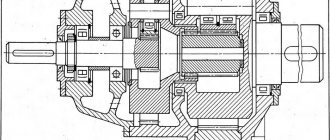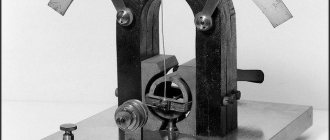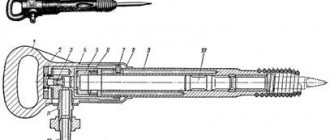A voltmeter is a device whose purpose is to measure electromotive force (EMF) in a certain section of an electrical circuit, or more simply, a device for measuring voltage (electric potential difference). This device is always connected in parallel with the battery or load. The voltmeter displays the measured value in Volts.
If we talk about an ideal voltmeter, then it should have infinite internal resistance in order to accurately measure voltage and not have any side effects on the circuit. That is why in high-class devices they try to make the maximum possible internal resistance, on which the accuracy of measurement and the interference created by the voltmeter in the electrical circuit depend.
Figure - Voltage measurement formulas
If we talk about the installation method, voltmeters are divided into three main groups:
• Stationary;
• Panel;
• Portable;
As the name implies, stationary devices are used where constant monitoring is required, panel devices are used in distribution panels and on instrument panels, and portable devices are used in compact devices that can be used anywhere.
Figure - Voltmeter connection diagram
Watch a video about connecting a voltmeter:
Classification of devices
A voltmeter is a device that is used in electrical engineering along with an ammeter or ohmmeter. The device can be connected directly to a power source or in parallel with the load. Just by the name of the device, even a novice home DIYer can tell exactly what a voltmeter is needed for. A multi-stage system is used to classify these devices.
According to purpose
If the meter body is marked B2, then it is intended for use in DC electrical circuits. There are also devices for measuring alternating voltage, designated B3.
Types of voltmeters according to purpose:
- Phase. Designed to determine the indicators of the quadrature components of the fundamental harmonic of electric current and are marked - B5.
- Universal - marking B7. Allows you to take readings in any electrical circuits. Many models are equipped with a set of shunts to ensure a safe connection.
- Pulse - B4. These meters are widely used due to their functionality. With their help, you can detect impulse noise in the electrical network.
- Selective frequency search meters. These devices have the largest dimensions and allow processing complex signals, isolating harmonic elements from them. They can often look like radios.
All these types of voltmeters are widely used in everyday life or industry.
By external signs
Voltage meters can be divided into three large groups. Among them, stationary ones have the largest dimensions.
They are designed for continuous monitoring of electrical network performance. This may be necessary to maintain the smooth operation of various equipment. These devices are characterized by high sensitivity and measurement accuracy.
Devices that are mounted in electrical cabinets are called panel devices. Compared to stationary ones, they are smaller in size. Portable (autonomous) meters, due to their light weight and dimensions, are extremely convenient to transport, so they are widely used in everyday life. These meters are also equipped with probes for quick readings.
Range and method of measurement
You don't have to be a professional electrician to know what voltage is measured in. The basic unit is Volt (V). However, in electrical circuits the voltage can be different.
All voltage meters can be divided into several groups according to the range of measured values:
- microvoltmeters - allow you to measure millionths of a volt;
- millivoltmeters - capable of recording thousandths of a voltage unit;
- kilovoltmeters - designed to determine high voltage, measured in kV.
Meters can be electromechanical (pointer), as well as electronic (digital). Devices of the first type are equipped with a digital scale and a pointer mounted on a frame with a winding. They have a certain sensitivity. This is the coefficient of dependence between the actual electrical voltage in the circuit and the angle of rotation of the arrow.
The device of an electronic type voltmeter requires a display to display the readings taken.
In addition, the design includes a special microcircuit whose task is to convert the analog signal to a digital one. These meters are highly sensitive and reliable, so their cost is higher than their electromechanical counterparts.
Application of a multimeter
In most cases, it is convenient to use specialized instruments to carry out measurements. There are a large number of varieties, the use of which allows serial and parallel connection in a circuit. The connection diagram of the voltmeter implies only a parallel connection.
In some cases, you can use a multimeter. This measuring device operates on a universal principle. It can be used to measure various electrical quantities, including DC and AC voltage. To do this, you need to take the following steps:
- Set the switch to the appropriate mode for measuring DC or AC voltage.
- Select measurement range. To do this, you need to point to the nearest value that exceeds the expected one.
- Connect the black and red probes. The first is inserted into the COM socket, the second into the adjacent one marked V.
- The probes are connected in parallel to the part being measured, maintaining the correct polarity.
- The display shows the measurement result.
After finishing work, the mode switching knob should be moved to the “Off” position. The advantage of using a multimeter is its versatility and ease of use.
Principle of operation
Electromechanical type meters were the first to be created. They operate using the magnetoelectric principle. A permanent magnet is fixedly fixed, and a steel core is installed between its poles. This structural element is installed in such a way that a constant electromagnetic field can be formed in the annular air gap.
A frame made of aluminum is installed in the gap on the axle shafts. She is able to move freely. There is also a spool of thin wire on the frame. The indicator arrow of the device is attached to the frame using springs. As soon as an electric current begins to pass through the device, an electromagnetic field appears in the winding. The frame interacts with it and deflects along with the arrow to a distance corresponding to the voltage value.
The design of the meter also contains an induction damper - an aluminum plate mounted on a frame with an arrow. In accordance with Lenz's rule, eddy currents arising in the damper interact with the magnetic field that generated them and slow down the oscillations of the device pointer. To achieve the required measurement accuracy, the device must not be exposed to gravity during operation.
To solve this problem, the moving part of the meter is equipped with a system of weights moving on rods. In addition, to ensure accurate measurements, it is necessary to reduce the friction force of the steel tips . This is achieved through the use of special wear-resistant steels. Parts made from them are polished.
Before starting the measurement, the user needs to set the indicator arrow to the zero position.
For this purpose, the design of the device includes a special adjustment screw connected to a spring. This is a classic design, but today there are devices containing magnets of different shapes. Moreover, in some designs the magnet is movable.
History of invention
The Italian scientist Alessandro Volta, after conducting a series of experiments with electricity, comes to the conclusion that electric current can be obtained by combining metals with liquid.
By placing copper plates coated with zinc in acid, in 1800 he created the first electrochemical energy source, later called the “voltaic column”. He also establishes that when two different metals are joined, a force is generated, which is expended in the work of moving an electric charge from one point to another. In this case, the displaced charge changes its potential (the amount of energy) it possesses. The difference between the initial potential and the final potential is called “voltage”.
To measure the amount of electricity, Volt uses a metal rod inserted into a rubber stopper and placed in a bottle. He puts straws on the lower end, located in the bottle, and a ball on the other. The scientist observes that when the ball comes into contact with an electrified substance, the straws repel. This allows him to judge the degree of charge of the material.
Volt proved the existence of voltage by conducting the following experiment. A copper and zinc disk was placed on the electroscope (a device that records charge). A thin layer of dielectric is laid between them. For a short time, the physicist connected the metals together with a wire. The petals on the electroscope moved slightly apart. Next, the disks moved apart to a greater distance, while the recorder petals diverged even more.
In fact, this was the first experiment to measure, albeit in rough form, voltage. In 1830, the English scientist Michael Faraday discovered the phenomenon of electromagnetic induction, which was subsequently used to create a number of electrical measuring instruments.
In 1881, French physicist Arsene D'Arsonval created a device consisting of a coil and a pointer placed in a constant magnetic field. Electric current was supplied to the coil, causing the needle to deviate from its initial position. In the same year, the International Electrotechnical Congress was held, at which the designations of electrical quantities were adopted. The device designed to measure potential differences was called a voltmeter, and voltage began to be measured in volts.
Main characteristics
The higher the internal resistance of the device, the less influence it has on the operation of the measured electrical circuit. Meters with high output impedance are more accurate. When choosing a voltmeter, you need to pay attention to its characteristics. Among them, the most important are the following:
- measurement range;
- internal resistance;
- AC frequency range;
- measurement error.
The measuring range of the device is selected depending on what quantities you plan to work with. Most models are capable of measuring voltage from several tens of millivolts to hundreds of kilovolts. Accuracy is also an important characteristic.
This indicator is determined by the manufacturer using special tests. You can get acquainted with the characteristics of the device in its operating instructions.
Video
What does a voltmeter measure and how to use it
Organic Shop Kitchen Restoring Night Cream for the face “Bayu-Bai”, 100 ml
130 ₽ More details
ARAVIA Professional Intensive Moisture Face Cream with urea (10%), 150 ml
405 ₽ More details
Price tags
Terms of use
The device must be connected to the circuit in parallel. You should make sure that it has the measurement range that is intended. Other rules for proper operation include:
- polarity must be observed;
- to measure the voltage at the power source, the device is connected directly to its terminals;
- It is not allowed to check high-voltage sections of the circuit with voltmeters that are not designed for high voltage;
- When using a universal meter, you must first select the desired operating mode.
When choosing a device, users should focus on their own budget and assigned tasks. In order for the purchased device to serve for many years, all operating rules must be followed.
Let's consider several voltmeters from different manufacturers
1. V3-57 - microvoltmeter
Measuring device model V3-57 - voltmeter-converter rms. indications. Designed for RMS measurements. voltage values of arbitrary shape and their linear transformation. in constant voltage current. The instrument scale is marked in rms. voltage values and decibels (from 0 dB to 0.775 V). It is used for monitoring and adjusting various radio-television devices and communications equipment, calculating the frequency characteristics of broadband devices, examining noise-resistant signals, etc.
Basic technical data:
— Voltage measurement limits 10 μV - 300 V with boundary zones: 0.03-0.1-0.3-1-3-10-30-100-300 mV 1-3-10-30-100-300 V
— Frequency limits 5 Hz - 5 MHz
— Permissible error, %: ±1 (30-300 mV), ±1.5 (1-10 mV), ±2.5 (0.1-0.3 mV and 1-300 V), ±4 (0 .03 mV)
— Input resistance 5 MOhm ±20%
— Input capacitance: 27pF (0.03-300 mV) and 12 pF (1-300 V)
— Voltage at the output of the linear converter. 1 V
— Resistance at the output of the linear converter. 1 kΩ ±10%
— Limit coefficient. signal amplitude 6*(Uk/Ux)
see also
- Analog voltmeters
- Voltage
Unfortunately, it is not easy to provide all the knowledge about digital voltmeters in one article. But I tried. If you show interest in revealing the details, I will definitely write a sequel! I hope that now you understand what digital voltmeters are and what all this is needed for, and if you don’t understand, or if you have any comments, then feel free to write or ask in the comments, I will be happy to answer. In order to gain a deeper understanding, I strongly recommend that you study all the information from the category METROLOGY AND ELECTRORADIO MEASUREMENTS
Write answers to questions for self-test in the comments, we will check, or ask your own question on this topic.
Connection diagrams and methods
The question often arises of how to connect an ammeter, in series or in parallel. Connecting the device in question into an electrical circuit break is not difficult. For safety reasons, this procedure is performed when the power source is turned off. You need to make sure in advance that the maximum current will not exceed the permissible values of the device. Such scales are duplicated in the accompanying technical documentation. When the supply voltage is applied, readings are taken. You need to wait until the needle stops oscillating. When it moves in the opposite direction, the polarity of the connection changes. If the current is too high, additional shunting is used.
The connection diagram of the device can be direct or indirect. In the first case, the device is directly connected to the electrical circuit between the power source and the load.
Before connecting the device, you must consider:
- direct or alternating current in the electrical network;
- Is the polarity of the device correct?
- the arrow of the device should be located beyond the middle of the scale;
- limits for measuring the maximum possible current surges in the circuit;
- whether the external environment meets the recommended indicators;
- Is the measurement location free from vibration?
Connecting the device
In DC circuit
Direct current can pass through different electrical circuits. As an example, we can cite all kinds of chargers and power supplies. To repair such devices, the technician must have an understanding of how the ammeter is connected to the electrical circuit.
At home, such skills will also not be superfluous. They help a person who is not too keen on radio electronics to determine for himself, for example, the time it takes to charge the battery from a camera.
To conduct the experiment, you will need a fully charged battery with a nominal voltage of, for example, 3.5 V. In addition, you need to use a lamp of the same rating to create a series circuit:
- battery;
- ammeter;
- bulb.
The entry that is marked on the measuring device is recorded. For example, a lighting fixture will consume 150 milliamps of electricity, and the battery has a capacity of 1500 milliamp-hours. Therefore, it will work for 10 hours, delivering a current of 150 mA.
Connecting to the charger
The question often arises of how to properly connect an ammeter to a charger. When using a charger, the need arises to measure the current. This will make it possible to control the process of accumulating electricity by the battery, and avoid overcharging and undercharging. As a result, the service life of the battery will increase significantly.
We recommend reading: Refinement of the Chinese super bright flashlight UltraFire XML-T6
When operating a large number of technical devices, it becomes necessary to control the current strength. The ammeter needles or indicators on the monitor of a discrete device will show the operator such a physical parameter. The measurements taken are needed to maintain the operating condition and to signal the occurrence of an emergency.
Connection process
What does a voltmeter measure?
To take readings of the network voltage in a certain section of the circuit, a voltmeter is connected to it only in parallel, regardless of the type of device, since in this case it has minimal influence on the movement of electric current. Voltage monitoring with this meter can be carried out both at the load and at the power source.
Diagram of parallel connection of a voltmeter to a network
When a voltmeter is wedged into an electrical circuit in series, it actually breaks due to the high internal resistance; accordingly, the measurements obtained will be incorrect, and in many cases a short circuit or failure of the circuit elements, including the meter, may occur.
On a note. Do not confuse a voltmeter with an ammeter, which is connected to the mains in series, since the resistance when measuring current should be minimal.
The device is connected to two sections of the circuit by clamping the wires with special electrodes or clamps.
If you need to measure sections of a DC electrical circuit with a known high voltage or you need to obtain ultra-precise data on this parameter, then you should use additional resistance, which is created by resistors - the simplest voltage dividers.
Connecting additional resistance (resistors) to the circuit to increase the accuracy of the voltmeter
When making measurements in high-voltage AC power networks, you can use not only resistors, but also instrument transformers as additional resistance. It is with alternating current that electricians usually use voltage transformers, since they not only reduce the voltage for the end user, but also separate the measuring circuit from the power circuit.
Appearance of the voltage transformer
Rules for connecting voltmeters to a circuit:
- The correct measuring range of the device must be selected. You cannot measure high voltage with a voltmeter, which is designed for measuring the parameters of microcircuits;
- If the device reading is close to the limit value, you should work with it carefully, since a jump in the EMF can damage its windings;
- The pointer device must be positioned according to the instructions: either vertically or horizontally. When monitoring readings, it is recommended to exclude the influence of electromagnetic fields on the device and vibration waves;
- Voltmeters can be connected to a circuit that is already energized, however, at dangerous values of this indicator, it would be useful to use special gloves and a dielectric cloth (mat);
- If the arrow in an analog device gives a non-zero result before starting to take readings, then it is necessary to reset it with a regulating element - a screw;
- Periodically, it is necessary to carry out calibration measures on the device, which will guarantee the accuracy of the measurements it produces;
- When using the device for the first time, it is worth connecting it to a de-energized network - only when all the terminals and wires of the device are connected, the current turns on;
- During measuring procedures, to avoid injury, it is recommended that you familiarize yourself with the safety precautions specified in the instructions.
When monitoring voltage in different circuits, various voltmeters and additional devices (resistors, transformers for them) can be used; to obtain ultra-precise measurement results, it is important to take into account the features of each of them.
Security measures
Unlike other devices, such as an ohmmeter or a megometer, when working with a voltmeter, you have to deal with voltage. At small values it does not pose a danger to humans. Great care must be taken when measuring voltages that can create a dangerous current flowing through the human body.
Voltage measurements must be accompanied by full compliance with safety regulations and operating regulations. This will prevent electrical injury. It is prohibited to work without protective equipment, such as rubber gloves and mats. Upon completion of the work, there should be no exposed live parts that could cause accidental contact by maintenance personnel.
The widespread use of voltage measurement in electrical engineering has led to the creation of voltmeters of various designs. They differ both in operating principle and in accuracy. The most popular are universal devices that can automatically select not only the limit, but also the type of controlled value.











